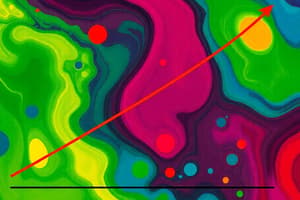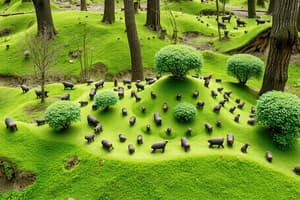Podcast
Questions and Answers
What characteristic is specific to exponential growth in populations?
What characteristic is specific to exponential growth in populations?
- It assumes limited resources are available.
- It incorporates carrying capacity.
- It assumes unlimited resources are available. (correct)
- It is represented by an S-curve.
Which of the following best describes logistic growth?
Which of the following best describes logistic growth?
- Population remains constant regardless of resources.
- Population growth slows as it approaches carrying capacity. (correct)
- Population size fluctuates without a stable limit.
- Population increases indefinitely without limitation.
Which factor does NOT influence population growth dynamics?
Which factor does NOT influence population growth dynamics?
- Density-dependent factors
- Density-independent factors
- Population age structure (correct)
- Biotic potential
What is a consequence of resource availability on population growth?
What is a consequence of resource availability on population growth?
In what way do density-dependent factors influence individual survival probability?
In what way do density-dependent factors influence individual survival probability?
What defines K-selected species in their reproductive strategy?
What defines K-selected species in their reproductive strategy?
Which age structure diagram indicates a declining population size?
Which age structure diagram indicates a declining population size?
What is the total fertility rate (TFR) considered to be at replacement level?
What is the total fertility rate (TFR) considered to be at replacement level?
What demographic parameter describes the difference between immigration and emigration?
What demographic parameter describes the difference between immigration and emigration?
Which type of survivorship curve typically represents species with high infant mortality rates?
Which type of survivorship curve typically represents species with high infant mortality rates?
Flashcards
Exponential Growth Model
Exponential Growth Model
Population growth assuming unlimited resources, determined by the intrinsic growth rate.
Logistic Growth Model
Logistic Growth Model
Population growth that considers carrying capacity and limited resources.
Carrying Capacity
Carrying Capacity
The maximum population size an environment can support.
Density-dependent factors
Density-dependent factors
Signup and view all the flashcards
Density-independent factors
Density-independent factors
Signup and view all the flashcards
Generalists vs Specialists
Generalists vs Specialists
Signup and view all the flashcards
K-selected species
K-selected species
Signup and view all the flashcards
r-selected species
r-selected species
Signup and view all the flashcards
Type I survivorship curve
Type I survivorship curve
Signup and view all the flashcards
Type III survivorship curve
Type III survivorship curve
Signup and view all the flashcards
Study Notes
Population Ecology (AP topics 3.1-3.5)
- Activities, labs, assignments for this topic include: density-dependent demonstrations (ball vs. rolling pin), exponential growth "riddles", logistic growth model analysis, K- vs. r-selection card sort, and human survivorship curves lab.
Population Growth Models
-
Exponential Growth:
- Assumes unlimited resources.
- Population growth is determined by intrinsic growth rate/biotic potential (maximum possible growth rate).
- Represented by a J-curve.
-
Logistic Growth:
- Incorporates limiting resources and carrying capacity (maximum population size the environment can support).
- Represented by an S-curve.
Factors Limiting Population Growth
-
Density-dependent factors:
- Affect individual survival probability.
- Examples include competition for resources, predation, disease.
-
Density-independent factors:
- Affect population growth regardless of density.
- Examples include natural disasters, climate change.
Impacts of Resource Availability
- Impacts of resource availability on population growth include overshoots and diebacks.
Studying That Suits You
Use AI to generate personalized quizzes and flashcards to suit your learning preferences.




